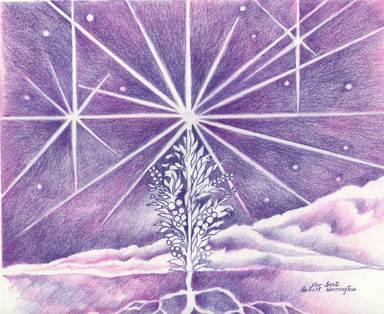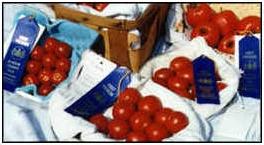 | ||
|
| ||
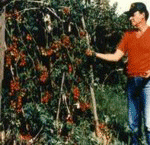
2000 Cherry Tomatoes From A Single Plant!Watch this free 15 minute video to learn about biodynamics and see the spectacular results for yourself. Follow the directions to grow your own 12 ft. high cherry tomato plant.Click Here
| |
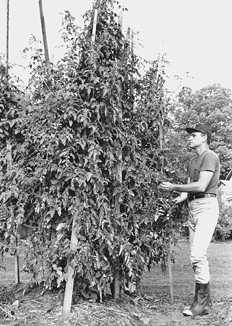 Rotheraine's Organic Tomatoes ( Plant) rotheraine.com L.A. Rotheraine with the Selke Biodynamic Cherry Tomato Plant |
Organic Tomatoes
|
"For years we've been saying the older we get, the less we understand. Rotheraine's explanations for what we are looking at when we see his giant tomato plant (Selke Organic,BD Cherry Tomato) is an example of this. The explanation may not be to our liking, but regular agricultural science does not have any other explanation for why the plant becomes so large despite the genetic limitations that normally are attributed to it" (See "The Hibernian Mysteries" also.)
Grant Nichols, Bradford Journal, February, 1992.
It is tragic that western agricultural science has forgotten about the energy interchange between the heavens (macrocosm) and earth (microcosm). Science knows that there are electromagnetic interchanges between the sun, moon and planets with the earth. It is only common sense to realize this interchange has to have an effect on plant growth.
Biodynamic agriculture gives us the opportunity to learn to harvest the energy from the whole universe - the opposite of atomic energy which works with the smallest aspect of matter. Atoms are only the result of heavenly activity. Biodynamics gives science a real intelligent design.
All microcosmic (earthly) life is but a result of heavenly (macrocosmic) activity. This concept, once known, has been forgotten in our times. The invention of the microscope and the subsequent discovery of microorganisms were primary elements in leading us to a one-sided view of life. This trend of thinking, focusing on the smallest particle, pervades all the scientific disciplines of the twentieth-century. It dominates agricultural concepts. This belief that dead, inorganic chemicals have the same nutritional content when added to the soil as organic matter stems from this type of thinking.
The onesided view of thinking of the earth and genetics as the key to life has reached a certain extreme in genetic engineering of tomato seeds. Lucille Salitan, an expert in farm and food research states: "The seeds (genetically engineered tomato seeds) were treated with mercury to ensure a higher percentage germination and every year some of this mercury leeches into the soil, and gets incorporated into the plants... The fields were first fumigated with methyl bromide, a chemical 100 times more destructive to the ozone layer than CFC. A chemical fertilizer which destroys millions of beneficial microorganisms per square inch was added to the soil with the seeds, and the boxed tomato was gassed with ethylene chlorodhydrin (a strong chemical) in order to turn it red. (From Tomato as an Economic Metaphor, Mankato State University, MN)
There is an alternative science to that described above. It is called Biodynamics. We use this method in our little three-quarter acre mountainside garden in Bradford, PA the ice box of Pennsylvania - as a part of our horticultural therapy program. The spectacular size and quality of the biodynamic vegetables produced over the past six years has the scientific community and the media watching very closely. So how do we produce such fine vegetables? How can anyone do the same thing?
We alter the climate in the garden with the unorthodox use of the traditional bio-dynamic preparations. (See chart of BD Preps.) We use the Pfeiffer Compost Starter as a tonic water. We water the roots of the plants to fix the nutrients and raise, add to, and purify the energy for the compost in which our plants grow. Horn silica is sprayed onto the plants to enhance light metabolism. This stimulates the photosynthetic formation of chlorophyll, and thus color, aroma, flavor and shelf life of the food. In 1993, Hugh Courtney of the Josephine Porter Institute of Applied Biodynamics, suggested we add the juice of valerian flowers (BD preparation 507) to our preparation of horn silica. This we then sprayed onto the plants. He speculated that this would create an ethereal skin that would contain the vital energies the biodynamic preparations bring into our garden. Using this mixture in 1993, we took 25 ribbons out of 27 entries (17 blue) at the McKean County Fair. This year (1995) we continued to startle the public by taking 34 ribbons out of 34 entries 27 first place blue in major vegetable categories. The Pennsylvania Department of Agriculture awarded the prize money. They know our science is special!
UPDATE (We use the B.D. Field Spray both as a foliar spray, soil spray, and to make a clay dip for plant roots when we transplant them in the soil. Because of this, we no longer use the B.D. Compost Starter to in-water our plants.)
The ramification of using new combinations of biodynamic preparations for the world's food chain and seed strains is awesome. Fruition is increased beyond normal capacities of climatic conditions, and seeds can be strengthened by reuniting them with their heavenly creative source.
Much as a photographer captures an image on film, we capture plant images from the heavens in organic matter.
Science must relearn what the ancient civilizations on the planet knew, and our Selke B.D. Cherry Tomato plants and seeds demonstrate - plants are small models of the stars and planets. Much as a photographer captures an image on film, we capture plant images from the heavens in organic matter. Thus, we can say seeds and plants are the energy from the stars, frozen and molded into earthly substances - each species a model of a particular group of stars. Our Selke B.D. Cherry Tomato seeds are stellar enhanced to grow in raw garbage - table scraps built in our organic hills and thrown on them during the growing season. They take advantage of this ancient wisdom - they are this ancient wisdom in practice.
Biodynamic agriculture was first introduced to the world in 1924, by Dr. Rudolf Steiner. Degeneration of seeds and a search for ways to stop their decline led to lectures that have become the basis of biodynamic agricultural science. They are available today as the book called Agriculture (Josephine Porter Institute, POB 133, Woolwine, VA, 24185. (276) 930-2463)
The book Agriculture shows genetics and nutrition to be a consequence of life or vital force emanating from the heavens. Steiner indicates "...when plants become foods they evolve in such a way that the substances in them become food for animals and humans, then Mars, Jupiter and Saturn, working via the siliceous elements are included into the process. The siliceous nature opens the plant to the wide spaces of the universe and awakens the senses of the plant being in such a way as to receive from all quarters of the universe the forces of the distant planets. From the sphere of the Moon, Venus and Mercury. . . it receives all that makes it capable of reproduction."
"..If you have apricots or plums with a fine taste, this taste, just like the color of the flowers, is a cosmic quality which has been carried right into the fruit. In the yellow apple, you are eating Jupiter, in the plum you are actually eating Saturn.." "...thus we see Mars in the red flower, Jupiter in the yellow or white flower, Saturn in the blue flower, while in the green leaf the Sun itself...."
Since plants attempt to replicate their heavenly image, changing the nature of the seed results in an impediment to such a heavenly replication.
In the book Agriculture by Dr. Rudolf Steiner, Steiner states :
That which is imaged in the single plant, is always the image of some cosmic constellation. Say we plant the seed of some plant in the earth. Here in this seed we have the stamp or impress of the whole Cosmos - from one cosmic aspect or another. The constellation takes effect in the seed; thereby it receives its special form. (This concept was the inspiration for the drawing below, "STARSEED", by Robert Harrington. Click here for animation: The Biodynamic Aspects of the Heavens Creating Plants)
|
STARSEED |
This knowledge has been forgotten today. But the farther we go back in human history the more humanity knew the above mentioned facts.
Steiner's student, Ehrenfried Pfeiffer, a noted biodynamic scientist stated in the preface of the 1977 edition of Agriculture: "The task was to reunite the plant, viewed as a system of forces under the influence of cosmic activities, with nature as a whole. Rudolf Steiner pointed out that many plants which had been 'violated,' in the sense of having been estranged from their cosmic origin, were already so far gone in degeneration that at the end of the century their propagation would be unreliable."
Twentieth century agricultural science is based on food grown from genetically altered and hybrid seeds, raised on large doses of chemical fertilizer. Since plants attempt to replicate their heavenly image, changing the nature of the seed results in an impediment to such a heavenly replication. Biodynamic science, the biodynamic preparations, and the Pfeiffer biodynamic Compost Starter and B.D. Field Spray enhance these natural energies. Why is the entire world not using the biodynamic super science to produce superior plants, seeds and animals? Biodynamics eliminates the need for chemical fertilizers or pesticides and produces the healthiest food possible for animal and human consumption. It cleans up the soil and garden atmosphere, creating a healthier climate for all who work in a biodynamic garden or farm. Most universities are unaware of this science. Their approach to seed creation still bases itself on the concept that genetics is the primary cause of life. Genetic engineering of seeds leads to inferior seeds and plants, thus food. This allows companies that genetically engineer seeds to ruin our food through their inferior seeds.You can help change this by growing one plant!
The Selke Organic B.D. Cherry Tomato plants and seeds demonstrate what can be done with plants if the biodynamic principles in Rudolf Steiner's book Agriculture are studied and put into practice. They can grow twelve feet high and produce over 2000 delicious tomatoes per plant, if our organic hill is used along with planting and transplanting dates. (More Information on the Evergreen Elm Organic Biodynamic Tomato Seeds.)
Credits: Biodynamics March/April 1995.
Bradford Journal September 1994

Evergreen Elm's 1995 Blue Ribbon Vegetables from "A Tale of Two Tomatoes."
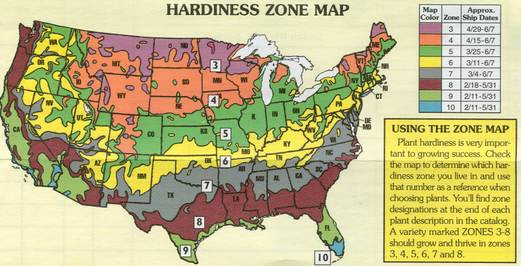
The little orange dot on the PA-NY border is McKean County
Chart of Evergreen Elm's Biodynamic Garden vs Traditional Agricultural Growing Methods in open competition at the McKean County Fair:* **
|
YEAR |
ENTRIES |
RIBBONS |
BLUE |
|
1991 |
14 |
11 |
8 |
|
1992 |
21 |
18 |
11 |
|
In 1993 Evergreen Elm's Master Gardener L.A. Rotheraine began experimenting with unorthodox combinations of the biodynamic preparations at the suggestion of Hugh Courtney* ** of the Josephine Porter Institute of Applied Biodynamics: | |||
|
1993 |
27 |
25 |
17 |
|
1994 |
33 |
31 |
17 |
|
1995 |
34 |
34 |
27 |
|
1996 |
30* |
30 |
21 |
|
1997 |
30 |
28 |
26 |
|
1998 |
30 |
30 |
20 |
|
1999 |
29 |
29 |
20 |
|
2000 |
30 |
30 |
22 |
|
2001 |
29 |
29 |
24 |
|
2002 |
30 |
30 |
23 |
|
2003 |
29 |
29 |
14 |
|
2004 |
30 |
30 |
22 |
|
2005 |
29 |
28 |
18 |
|
2006 |
30 |
29 |
23 |
|
2007 |
29 |
27 |
24 |
|
2008 |
29 |
28 |
20 |
|
2009 |
29 |
29 |
21 |
2010 |
29 |
28 |
20 |
|
2011 |
30 |
30 |
24 |
|
2012 |
30 |
30 |
21 |
2013 |
30 |
30 |
23 |
|
2014 |
30 |
30 |
20 |
| 2015 | 30 | 29 | 20 |
| 2016 | 30 | 30 | 24 |
| 2017 | 28 | 28 | 17 |
| 2018 | 28 | 27 | 20 |
Evergreen Elm's Biodynamic Cherry Tomato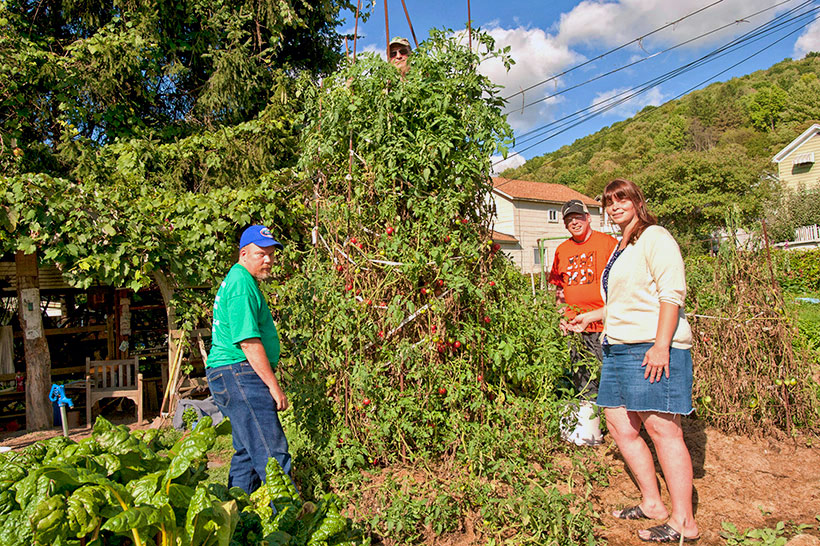
Era photo by Alan Hancock
From left, biodynamic gardeners Jim Oehler, L.A. Rotheraine, standing on ladder, Jeff Van Scooter and Brandi Buck stand in front of a 10 foot tall cherry tomato plant on Wednesday afternoon at the Evergreen Elm garden on Elm Street. Rotheraine claims it is the strongest tomato plant on the Planet Earth. “With all the billions of dollars that the genetic engineering seed companies spend, they cannot come close to producing the unique seed that Evergreen Elm makes to create this plant,” Rotheraine said. Evergreen Elm Executive Director Garry Pugrant said the agency has seeds available from the giant tomato plant. Donations would be accepted.
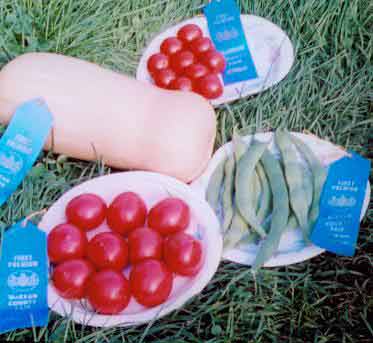 rotheraine's organic tomatoes - grown in old horse manure and garbage ( table scraps) Rotheraine.com |
Rotheraines Organic Tomatoes
L. A. Rotheraine, Evergreen Elm's Master Gardener gave Jeff Neatrour of Crosby a baby Selke Biodynamic Cherry Tomato Plant, through his friend Donny Gustafson. These are the results. Neatrour grew the plant from table scraps and soil. The plant reached 12 feet tall and Neatrour picked 2,828 tomatoes off the plant. The girl next to the plant is Neatrour's granddaughter, Payton Kaziska, 3.
New Strain Produces Giant Cherry Tomatoes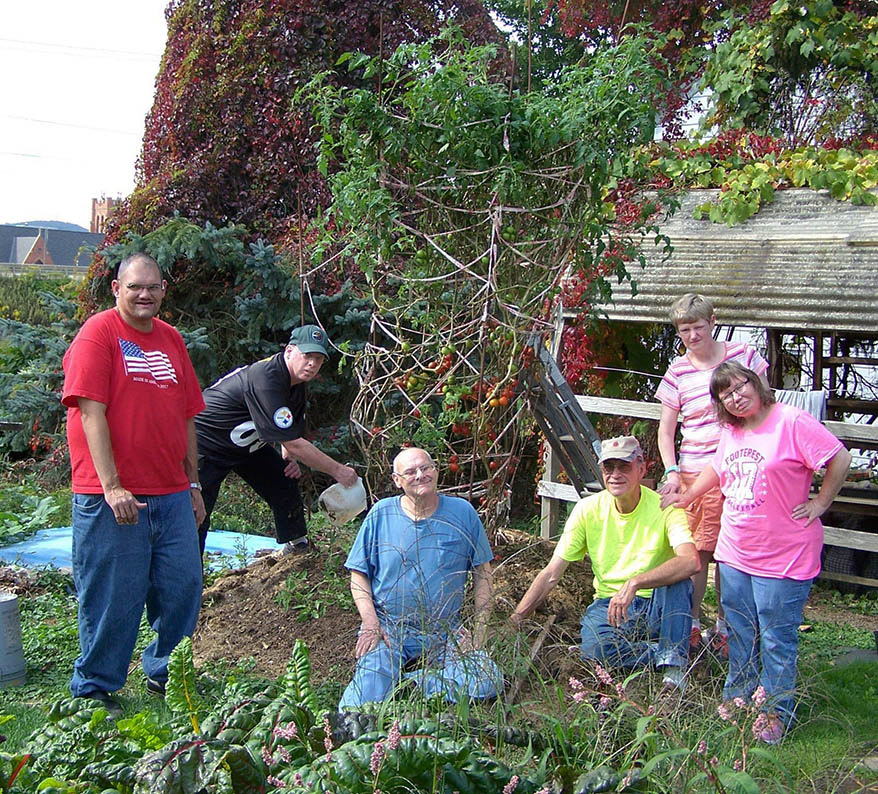
Bradford Journal Photo
L.A Rotheraine poses with the “Patty Price Biodynamic Cherry Tomato Plant,” and some of his Elm Street Gardeners, September 17th at the garden. “This giant plant is a sister to the ‘Selke Biodynamic Cherry,’” said Rotheraine. “It’s over 10 feet high and produces cherry tomatoes 2-3 time the size of the Selke,” he continued. Left to right in the photo are Robert Tubbs, Jeff Van Scoter, Randy Johnson, L.A. Rotheraine, Patty Price, and Kari Johnson. Rotheraine tells us that he will go into more detail to explain the history of this unique new seed strain from the Elm Street Garden, in the Christmas edition of the Bradford Journal.
Copyright 1993 L.A. Rotheraine
First printed Biodynamic Journal & Lilipoh
